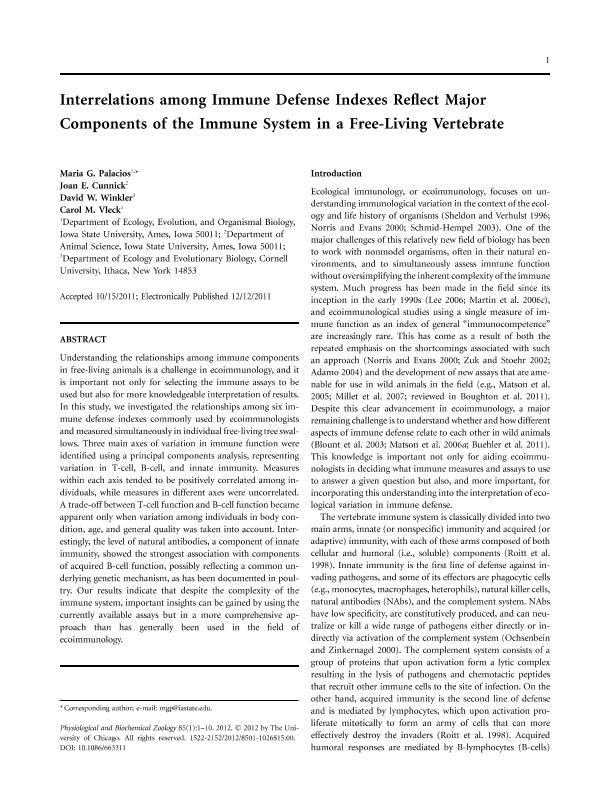Mostrar el registro sencillo del ítem
dc.contributor.author
Palacios, María Gabriela

dc.contributor.author
Cunnick, Joan E.
dc.contributor.author
Winkler, David W.
dc.contributor.author
Vleck, Carol M.
dc.date.available
2017-09-15T16:15:33Z
dc.date.issued
2011-12-12
dc.identifier.citation
Palacios, María Gabriela; Cunnick, Joan E.; Winkler, David W.; Vleck, Carol M.; Interrelations among immune defense indexes reflect major components of the immune system in a free-living vertebrate; University of Chicago Press; Physiological and Biochemical Zoology; 85; 1; 12-12-2011; 1-10
dc.identifier.issn
1522-2152
dc.identifier.uri
http://hdl.handle.net/11336/24363
dc.description.abstract
Understanding the relationships among immune components in free-living animals is a challenge in ecoimmunology, and it is important not only for selecting the immune assays to be used but also for more knowledgeable interpretation of results. In this study, we investigated the relationships among six immune defense indexes commonly used by ecoimmunologists and measured simultaneously in individual free-living tree swallows. Three main axes of variation in immune function were identified using a principal components analysis, representing variation in T-cell, B-cell, and innate immunity. Measures within each axis tended to be positively correlated among individuals, while measures in different axes were uncorrelated. A trade-off between T-cell function and B-cell function became apparent only when variation among individuals in body condition, age, and general quality was taken into account. Interestingly, the level of natural antibodies, a component of innate immunity, showed the strongest association with components of acquired B-cell function, possibly reflecting a common underlying genetic mechanism, as has been documented in poultry. Our results indicate that despite the complexity of the immune system, important insights can be gained by using the currently available assays but in a more comprehensive approach than has generally been used in the field of ecoimmunology.
dc.format
application/pdf
dc.language.iso
eng
dc.publisher
University of Chicago Press

dc.rights
info:eu-repo/semantics/openAccess
dc.rights.uri
https://creativecommons.org/licenses/by-nc-sa/2.5/ar/
dc.subject
Complement
dc.subject
Ecological Immunology
dc.subject
Immunocompetence
dc.subject
Lymphocyte Proliferation
dc.subject
Natural Antibodies
dc.subject
Phytohemagglutinin
dc.subject
Tachycineta Bicolor
dc.subject
Trade-Off
dc.subject.classification
Bioquímica y Biología Molecular

dc.subject.classification
Ciencias Biológicas

dc.subject.classification
CIENCIAS NATURALES Y EXACTAS

dc.title
Interrelations among immune defense indexes reflect major components of the immune system in a free-living vertebrate
dc.type
info:eu-repo/semantics/article
dc.type
info:ar-repo/semantics/artículo
dc.type
info:eu-repo/semantics/publishedVersion
dc.date.updated
2017-09-07T16:51:48Z
dc.journal.volume
85
dc.journal.number
1
dc.journal.pagination
1-10
dc.journal.pais
Estados Unidos

dc.journal.ciudad
Chicago
dc.description.fil
Fil: Palacios, María Gabriela. Iowa State University; Estados Unidos. Consejo Nacional de Investigaciones Científicas y Técnicas; Argentina
dc.description.fil
Fil: Cunnick, Joan E.. Iowa State University; Estados Unidos
dc.description.fil
Fil: Winkler, David W.. Cornell University; Estados Unidos
dc.description.fil
Fil: Vleck, Carol M.. Iowa State University; Estados Unidos
dc.journal.title
Physiological and Biochemical Zoology

dc.relation.alternativeid
info:eu-repo/semantics/altIdentifier/url/http://www.journals.uchicago.edu/doi/10.1086/663311
dc.relation.alternativeid
info:eu-repo/semantics/altIdentifier/doi/http://dx.doi.org/10.1086/663311
Archivos asociados
